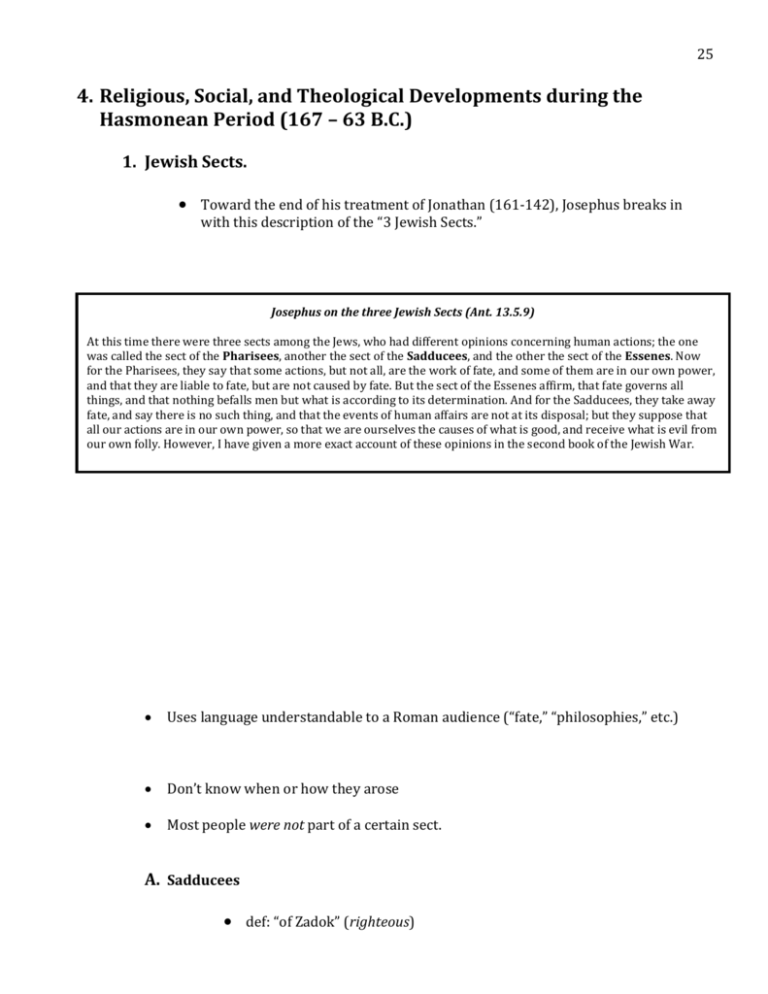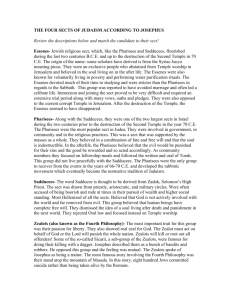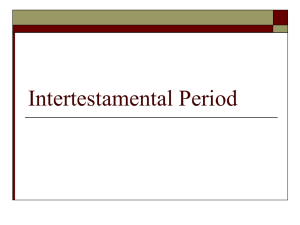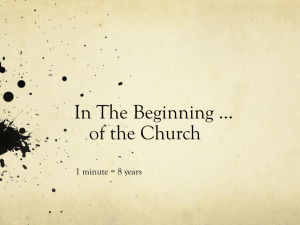Class notes 2
advertisement

25 4. Religious, Social, and Theological Developments during the Hasmonean Period (167 – 63 B.C.) 1. Jewish Sects. Toward the end of his treatment of Jonathan (161-142), Josephus breaks in with this description of the “3 Jewish Sects.” Josephus on the three Jewish Sects (Ant. 13.5.9) At this time there were three sects among the Jews, who had different opinions concerning human actions; the one was called the sect of the Pharisees, another the sect of the Sadducees, and the other the sect of the Essenes. Now for the Pharisees, they say that some actions, but not all, are the work of fate, and some of them are in our own power, and that they are liable to fate, but are not caused by fate. But the sect of the Essenes affirm, that fate governs all things, and that nothing befalls men but what is according to its determination. And for the Sadducees, they take away fate, and say there is no such thing, and that the events of human affairs are not at its disposal; but they suppose that all our actions are in our own power, so that we are ourselves the causes of what is good, and receive what is evil from our own folly. However, I have given a more exact account of these opinions in the second book of the Jewish War. Uses language understandable to a Roman audience (“fate,” “philosophies,” etc.) Don’t know when or how they arose Most people were not part of a certain sect. A. Sadducees def: “of Zadok” (righteous) 26 often seen as having a monopoly on the temple and priesthood. Not as many as the Pharisees Aristocratic, snobby, rude, part of the highest stratum of wealth. not liked by the people; alliances with Gentiles Distinctives: o Law of Moses. only accepted this part of scripture (Ant. 13.10.6; 18.2.4) o No resurrection, demons, angels NT, Josephus explains their quest for luxury? Not accused of living immorally, only living arrogantly. no angelic intervention (Acts 23:8) o Free will B. Essenses Josephus says the most about them (Ant. 18.2.5; War 2.8.2-13) see also Philo (Every Good Man is Free 12.75-87; Hypothetica 11.1-8) never mentioned in the NT Dead Sea Community? 27 Distinctives: o Predestination. o Immortality of the soul. o Temple is defiled. temple was defiled from a sinful priesthood. they were a temple o Separatist very monastic and separatist. Lived in communities in various cities, didn’t own property, lived simple, even ascetic, lives. Many were celibate (War 2.8.13 says some took wives). Sometime during the reign of either Jonathan or Simon, some Essenes established a monastic community by the Dead Sea (about 150 B.C.) . C. Pharisees Definition: o “the separated ones” 28 Number: o Ant. 17.42 gives the only numerical description of the Pharisees. In 10 B.C., Josephus says that there was “over 6,000 Pharisees” refused to take an oath to Caesar. Origin o mentioned here (reign of Jonathan), but that’s all. Problem of Sources: o Josephus (claims to have been a Pharisee) o Qumran Scrolls (some vague references; “seeker of smooth things”; regarding as compromisers) o Rabbinic Lit. (A.D. 200 -- ) much material but late and very biased. Pharisees were forefunners to the Rabbis. o NT. Paul, Acts, Gospels. Neg. View. Pos. View. Jesus accepted dinner invitations (Luke 7:36ff; 11:37ff; 14:1.); was warned by the Pharisees about Herod (Luke 13:31); seen in positive light in Acts 5:34-40; Nicodemus in John 3. o No undisputed written material, but Pss. Sol. Influence o Josephus o Some agree o Others (Neusner) says their focus shifted “from politics to piety” from BC to AD. 29 o Still others say that there were an insignificant group by the first century AD o Best approach: take what the sources say about the Pharisees at face value, recognizing their own contexts and agendas o Seems to have exerted a strong influence on the masses from the time of Simon’s reign (142-135) they wielded a lot of political power over the masses. During the reign of Alexandra Salome (76-67) during Alexandra Saloam’s rule, Josephus says that “she wore the crown, but the Pharisees ruled the people.” Hyrcanus II onward, significant influence Distinctives: o adhered to “oral law.” o resurrection. Josephus: “soul is immortal” (Ant. 18.2.3); “souls are immortal; souls of the righteous receive a new body after death” (War 2.8.14). NT: they believed in the resurrection of the dead (Acts 23:8) o Sovereignty and free will similar to a 4 point Calvinist! (not really, but…) 30 o Angels and Demons. believed in them. o Followed by the masses. generally, weren’t from circles of wealth and power Josephus says they were simply nicer than the Sadducees! Pharisees: Revolutionaries? (N.T. Wright, People of God, 188-203) o Pharisees and Revolts 134-104 (Hyrcanus II). Eleazer spoke out against the illegitimate rule of the Hasmoneans; said that Hyrcanus’s mother was taken captive (i.e. yo mamma’s a whore); started a riot. 103-76 (Jannaeus). Pharisees incited a riot and Jannaeus had many of them crucified. 37-4 BC (Herod). Two Pharisaic leaders, Pollio and Samaias, refused to take an oath of loyalty to Herod and Caesar and were severely punished. 4 BC. Those who tore down the eagle at the entrance to the temple were probably encouraged to do so by Pharisees (Judas and Matthias, the leaders of the incident, were called “most learned,” “unrivalled interpreters of the ancestral laws,” and “sages.” Terms associated with Pharisees.) AD 6 Judas the Zealot. Evidence that the Pharisees were linked with the great Galilean revolt led by Judas the Zealot. Josephus says (Ant. 18.4ff) Judas acted in collaboration with a certain Saddok, a Pharisee. AD 66-73: Jewish War. Simon ben Gamaliel, a Pharisee, was a close associate of the militant John of Gishala. Masada AD 73. Archaeological evidence suggests than some who took part in the last stand at Masada were Pharisees (mikvot were build to Pharisaic standards). o Sum: “We have found that in the period between the arrival of the Romans in 63 BC and the fall of Jerusalem in AD 70 there is a good deal of evidence for continuing political and revolutionary activity on the part of the Pharisees— evidence which Josephus has included in his account despite his clear wish to exonerate the party as a whole” (Wright, 193). 31 o So the Pharisees were not simply the religious “thought police,” who divorced theological disputes from the political arena. Rather, they were religious zealots, who wished for kingdom of God to come and overthrow their pagan overlords. And if the time was right, or if they were provoked enough, they were make this hope a reality through violent revolution. o Paul: The Pharisee zealous (Gal 1:14; Phil 3:5-6; Acts 22:3-4). Not, zeal for earning my way to heaven, but zealous to maintain the purity of the Jewish faith, so as to usher in the kingdom of God on earth. Pharisaic rejection of Jesus o they were expecting a more political, even revolutionary, messiah! o New Testament picture of the Pharisees Doesn’t denounce every Pharisee as being legalistic, but probably a certain number of them. D. Others Other so-called sects that arose during the Hasmonean period, or during the 1st century. Hasideans. “pious ones” only in 1 Macc 2:42; 7:13; 2 Macc 14:6 some have said these = Pharisees, others said Essenes know hardly anything about them Zealots formed in AD 6 from a man named Judas; Josephus labels this his “4th Philosophy” or sect. 32 like the Pharisees in belief, but much more militant and determined to overthrow the Gentile overlords. Judas led a brief revolt against Rome, but it was put down and Judas was killed. Siccari the name means “dagger men” Similar to the Zealots, the Sicarii were a group of violent bandits who specialized in assassination. mentioned in Acts 21:38 (“Assassins”) 2. Hellenization. Very different cultures: different gods, different way of thinking, dressing, relating to each other, customs, architecture, morals, etc. Alexander sought to “evangelize” the East with the Greek way of life. The East would never be the same. But how about the Jews? Distinguish between: o Palestinian Judaism o Diaspora Judaism distinguish between city and country dwellers, and upper and lower class Jews. Language 33 Persia – didn’t impose language on its subject (Persian?) Greece – imposed Greek as the language of government and commerce. Diaspora Jews o Paul preached in Diaspora synagogues in Greek (Acts 13:14-50; 14:1; 17:1-4, 10-13; 18:1-4), where it is said that the Gentiles listened on. o Many Jewish works written in the diaspora were composed in Greek: 2 Macc, Wisdom, Sybilline Oracles o Philo wrote not merely in Koine Greek, but in Classical Greek, and he was Jewish to the core! Palestinian Jews were mixed. However, many Palestinian Jews probably kept Aramaic, or to a lesser extent Hebrew, as their mother tongue. o Jews living in the country or in villages could have lived fine without knowing much Greek. o In the wake of A.E.’s persecution, there would have been a revival in a disdain for all things Greek, except, of course, by those Hellenized Jews o Many Aramaic phrases and words occur in the NT (Matt 27:46; Mark 5:41; 1 Cor 6:22). o Many Jewish books written in Palestine from 200 B.C. – A.D. 100 were written in Hebrew or Aramaic: Jubilees, Ben Sira, DSS, L.A.B. o Masada revolt: many manuscripts and inscriptions found: Greek, Latin, Hebrew, and Aramaic. 34 o Even Josephus, who was pretty Hellenized, admitted that his Greek was not very good and that he depended on a translator for his works (Apion 1.9). 3. Priesthood and Temple Josephus says there were around 20,000 priest living in Palestine at the end of the 1st cent. A.D. (Apion, 2.108) SUM: “The priests were the local representatives of mainline ‘official’ Judaism, as befits those who had both studied Torah themselves and, from time to time, had the privilege of serving Israel’s god in the Temple” (Wright, 209). At the top of the priestly chain were the “chief priests.” One of the chief priests would have been the High Priest. “bridge” between Rome and the Jews Temple visible religious symbol of Israel occupied 25% of Jerusalem Also a political and economic center. Money was kept (gifts, tithes, offerings). Lists of debts were kept. Temple taxes were collected. It drew worshippers from all other the Mediterranean, and thus drew commerce. 35 As such, it also become a symbol of corruption, hellenization, and exploitation. SUM: the temple was a very complex symbol in the first century 4. Sanhedrin and Synagogue Synagogue1 earliest reference we have to a Jewish synagogue is in the mid 3rd century B.C. (247-221 B.C.) in Egypt. But in Palestine, we have no evidence that Synagogues existed until the late 1st cent. B.C. (NT and Josephus attest to them). Function o extension of the temple. o priests and Levities provided leadership in the Synagogues. 1 probably had a more Hellenistic feel rule was very democratic: no priest or prophet ruling over it. The members of the group would elect a “captain,” Donald D. Binder, "Second Temple Synagogue FAQs." <http://www.pohick.org/sts/faqs.html> [accessed: 6/1/2010] 36 What was the General Outline of a Sabbath Service? During the Second Temple period, the Sabbath services began early Saturday morning. In Palestine, they lasted until around noon, when the service broke up and everyone went home for a mid-day meal. This may also have been the custom in the diaspora, though one of our sources, Philo, indicates that the services went into the afternoon. Our early sources give us only the barest outlines of a Sabbath service. Normally, portions of the Torah would be read, followed by a passage from the Prophets. In Palestine, the reading would typically have been in Hebrew, perhaps with an Aramaic translation. In the diaspora, the recitation would have been from the Septuagint, the Greek translation of the Hebrew Bible. While the reading was often done by one of the synagogue leaders, ordinary Jews could also be called upon to read. Following the recitations, either the reader or one of the other members of the synagogue would make an interpretive comment. Others in the congregation would then be free to offer their opinions, though the scribes, elders and other synagogue leaders probably led these exchanges. Communal prayer formed a part of the service, though it is unknown whether prayers were conducted at the beginning or the end of the service, or at both times. Practices probably varied from region to region. (from Donald Binder) Sanhedrin Sanhedrin – Gk. “assembly” intended to be a group of elders to serve as sort of a trial court for serious crimes. each city had a Sanhedrin, and in Jerusalem there was the Great Sandhedrin. The High Priest was the ruler of the G.S. 37 5. The Septuagint (250 B.C. – 50 B.C.) Overview Tradition: king Ptolomy Philedelphius sponsoring the translation for his library; they all (70) translated it exactly alike probably just the Pentateuch in 250 B.C. probable cause: Why was this important? first time we have God’s word being translated into another language NT writers tended to use the LXX LXX demonstrated the translatability of God’s message into another culture This shows that the gospels can embrace a culture in order to communicate God 5. Roman Period (63 BC – AD 135) 1. The end of Hasmonean rule: 63 B.C. – 37 B.C. Pompey took Jerusalem in 63 and brought Judea under Roman rule. Hyrcanus II remained the High Priest, but a Roman general (Aemilius Scaurus) ruled over the land. Israel returned to paying taxes to their Gentile overlords, thus ending their 80 year time of independence. This time was very rocky: o In Israel. On several occasions, Aristobulus and (or) his son Antigonus made attempts to reclaim Judea, each time being beat down by the Romans. 38 o In Rome. Meanwhile, in Rome there was the famous civil wars (49 B.C.). Julius Caesar ended up the winner, but he was assassinated in 44 B.C. This resulted in more civil wars between Mark Antony and Octavian (Augustus) vs. Cassius and Brutus. o Antony and Octavian were the victors. Rise of Antipater o During all this, a certain wealthy Idumean sheik named Antipater had proven to be a loyal and very powerful ally to the Roman victors. o he had previously been appointed “procurator” over Judea by Julius Caesar before he was assassinated; Herod was the “governor” of Galilee during this time as well. Antipater was assassinated in 43 B.C., and in 42 B.C. o Back in Judea, Antigonus, with the help of the Parthians, was able to take Jerusalem. In 40 B.C., he declared himself “king and high priest.” o Herod to Rome and declared “king of the Jews!” o Herod then went to Jerusalem, fought and defeated Antigonus and became the new “king of the Jews” in 37 B.C. 2. Herod the Great: 37 B.C. – 4 B.C. Introduction 39 o Idumean = “half Jew” Early Years: Consolidation o o Figure 1 Herod the Great o o SUM: Herod had thus killed off all those who could have tried to take his throne, thus consolidating his kingdom. He also instilled a sense of fear among the people. Middle Years: Prosperity o In 27 B.C., Caesar Octavian was proclaim “emperor” (Rome was a republic before), thus beginning the time of unprecedented peace and prosperity in the Mediterranean world. o Herod shared in this peace and prosperity and begun to build a kingdom that would rival Solomon’s. o Herod was in good with Rome and was given a good measure of autonomy— much greater than other so-called “client-kings.” o With the Jews, there were mixed feelings. 40 o Greek ways build many Greek style cities both in and outside Palestine. cities equipped with all things Greek: theaters, gymnasiums, and amphitheaters, where there would be athletic and gladiatorial games. children received a good, Greek education. o Jewish ways carefully observed the Jewish dietary laws Roman author: “I’d rather be Herod’s pig than Herod’s son” minted coins, but contained no image (2nd commandment) daughters only married circumcised men while he set up a lot of Greek cities with “all things Greek,” in more Jewish populated cities, he did inoffensive things. greatest demonstration of his so-called piety was the enhancements he made to the Jewish temple. o Building projects: Caesarea Philippi Herodium Masada Jewish Temple 41 o ruthless rule Later Years: Domestic Turmoil o married 10 times o 7 BC, had his two sons (from Mariamne), Alexander and Aristobulus, strangled to death, because he was told they were trying to kill him. o 5 days before he died, he had his other son, Antipater, killed. o toward the end of his life, he violated his own standard of not putting up images in Jerusalem, so as not to offend the pious Jews. He installed two golden eagles at the temple gates. Two Pharisees, Judas and Mattathias, incited the crowd to a near riot and tore down the eagles, perhaps thinking that Herod was too old to care at this time (he was 70). Herod burned them alive (Tomasino, 273). Herod’s Death o After Herod’s death, many riots and attempted revolts broke out. o Archelaus Antipas – tetrarch of Galilee and Perea Matt 14:1-12; mark 6:14-29; Luke 9:7-9; Luke 23:6-12) Philip – tetrarch of Banias and surrounding regions (N.E. of Jordan) Archelaus – tetrarch of Judea 42







